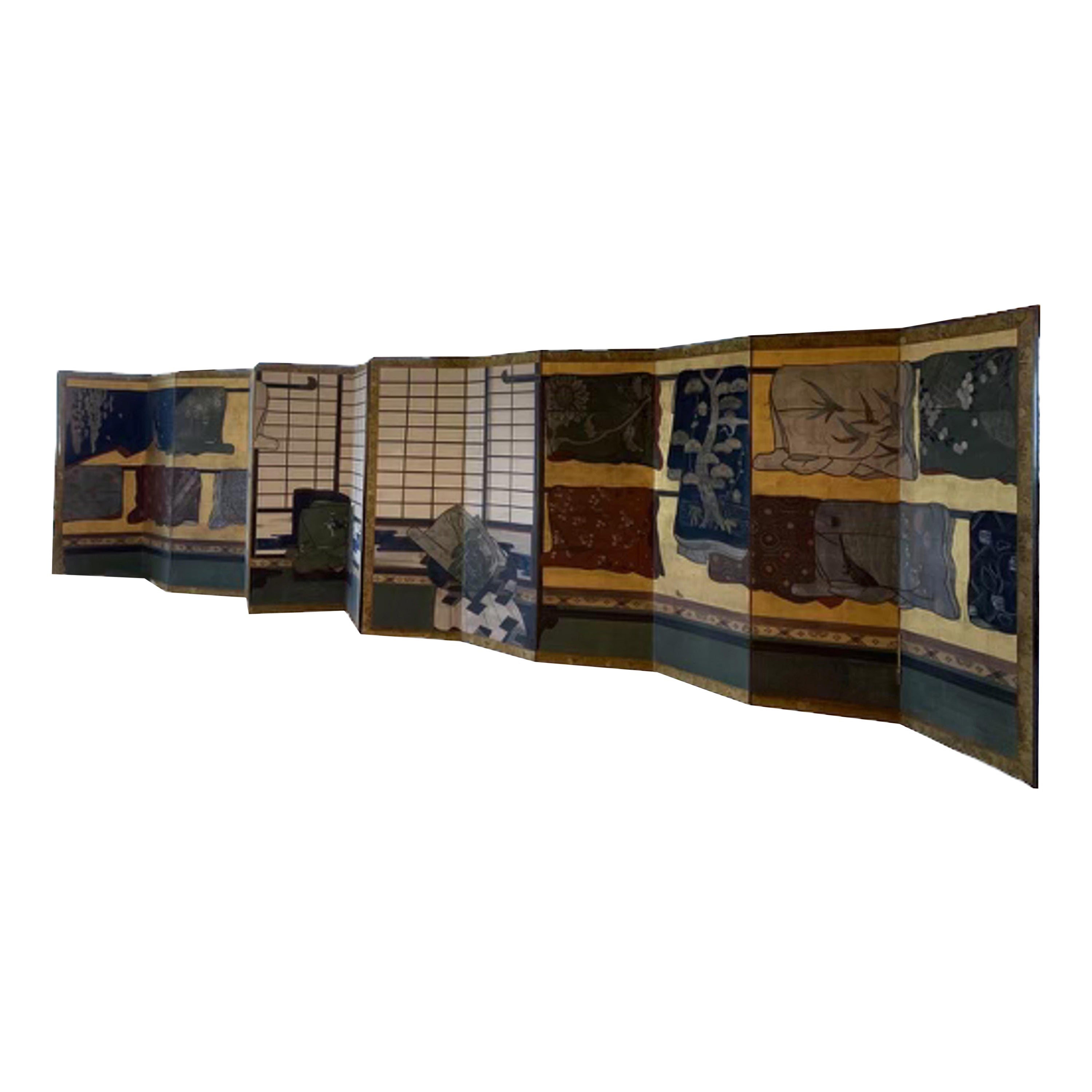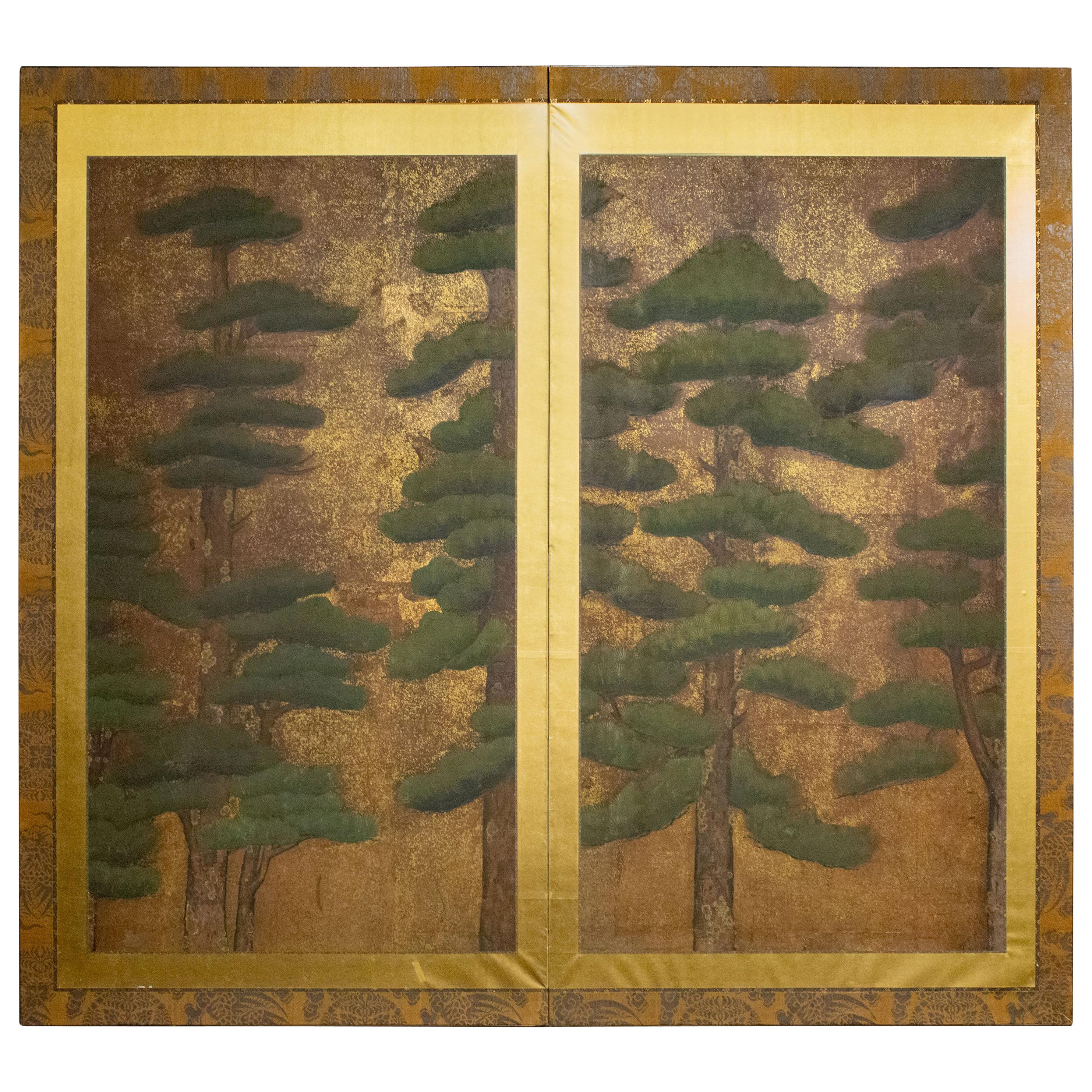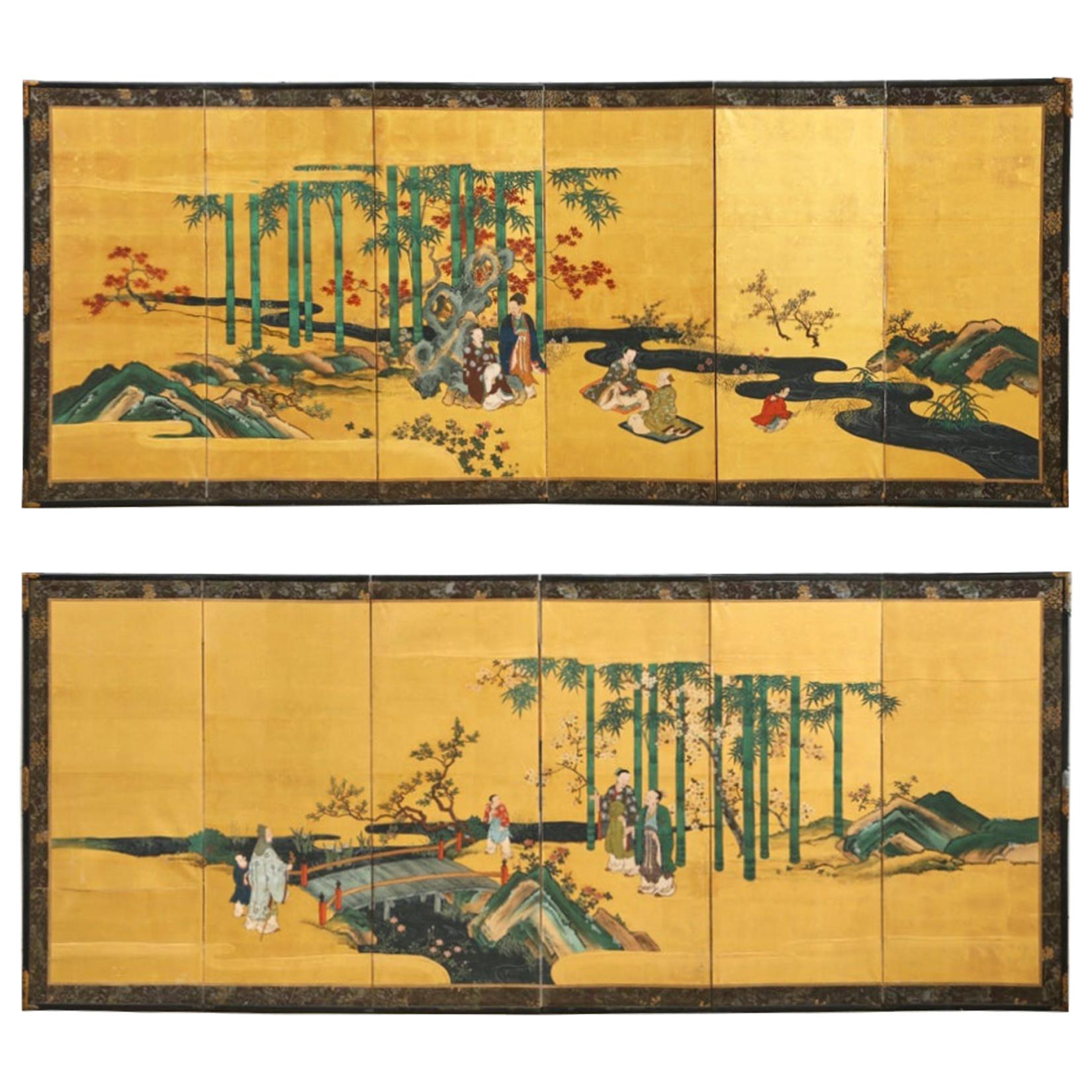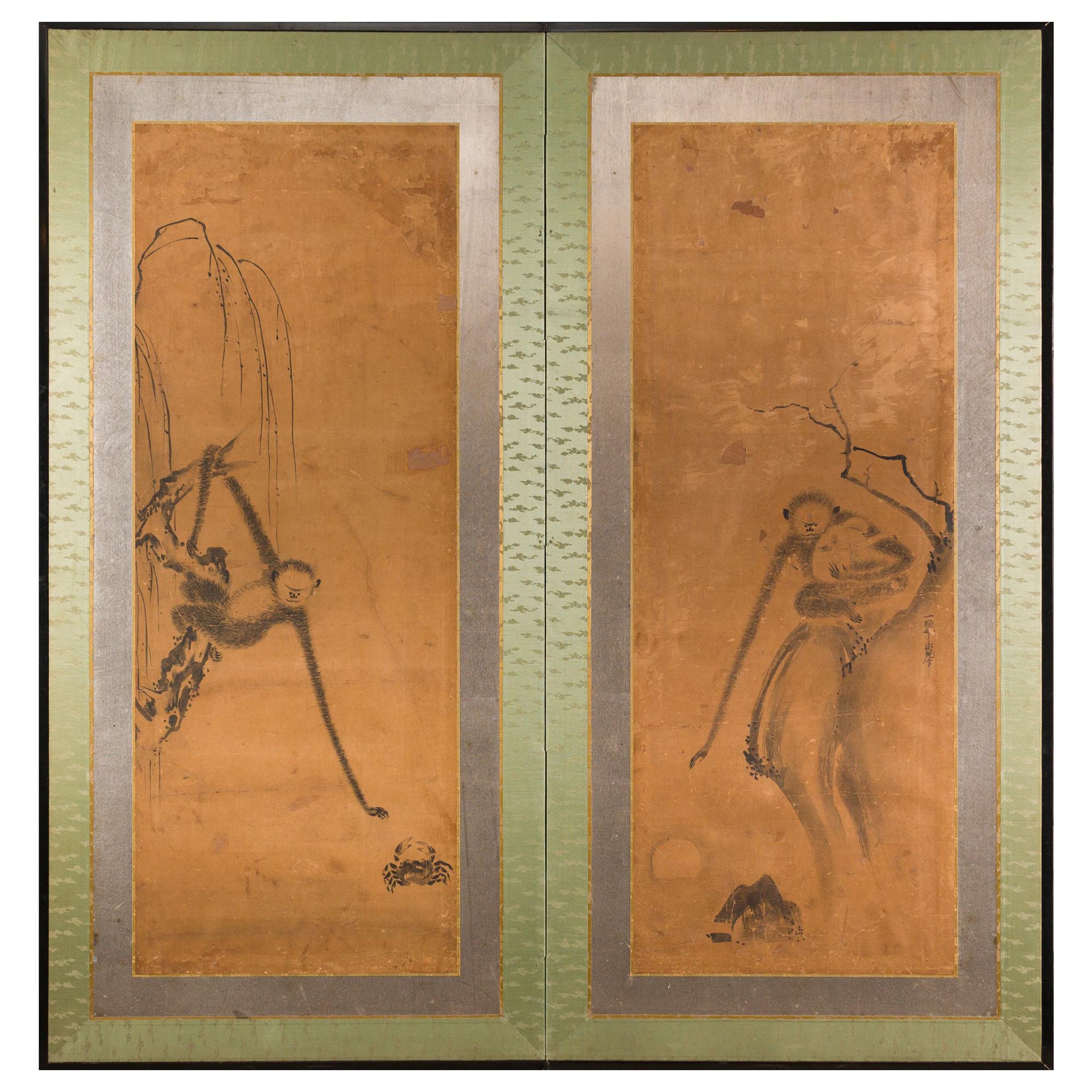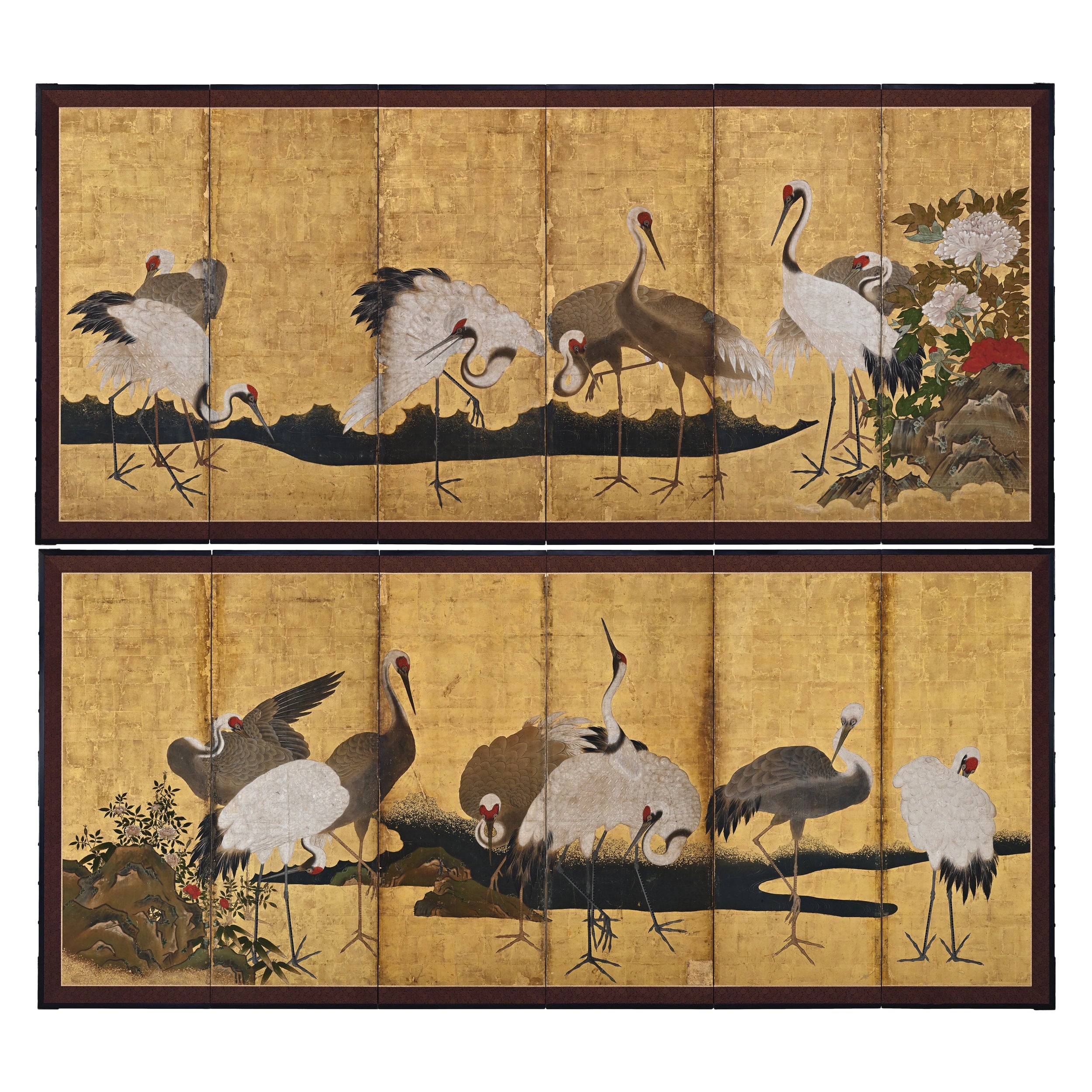Items Similar to 17th Century Japanese Edo Four Panel Screen Hotei with Chinese Sages
Video Loading
Want more images or videos?
Request additional images or videos from the seller
1 of 22
17th Century Japanese Edo Four Panel Screen Hotei with Chinese Sages
About the Item
Beautifully weathered late 17th/early 18th century Japanese edo period four panel byobu screen depicting hotei (fat monk) in a treed landscape with Chinese sages engaged in leisurely activities. The faded painting has a rich aged patina full of character and charm. Ink and natural color pigments painted on hand-crafted paper. Set in a lacquered frame with a faded silk brocade border. One panel is separated as seen in photos. Artist seals are too faint to identify. The characters robes have vivid colors and amazing intricacy. From an estate in Hollywood, CA.
- Dimensions:Height: 43.5 in (110.49 cm)Width: 80.5 in (204.47 cm)Depth: 0.75 in (1.91 cm)
- Style:Edo (Of the Period)
- Materials and Techniques:
- Place of Origin:
- Period:
- Date of Manufacture:Late 17th/Early 18th Century
- Condition:Wear consistent with age and use. Minor losses. Beautifully crafted with an aged patina. Age appropriate wear with panel separation, foxing, stains and losses as seen in photos.
- Seller Location:Rio Vista, CA
- Reference Number:1stDibs: LU1555238217542
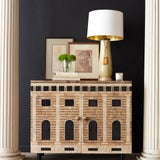
About the Seller
5.0
Erin Lane Estate is based in the San Francisco Bay Area, and its team of furniture restorers, art curators, professional appraisers and Asia specialists sources prime vintage and antique furniture from the finest estates in Northern and Southern California. Erin Lane Estate specializes in Hollywood Regency, McGuire, Chinese and Japanese pieces.
Diamond Seller
These expertly vetted sellers are 1stDibs' most experienced sellers and are rated highest by our customers.
Established in 2000
1stDibs seller since 2015
2,646 sales on 1stDibs
Typical response time: 1 hour
- ShippingRetrieving quote...Ships From: Rio Vista, CA
- Return PolicyA return for this item may be initiated within 1 day of delivery.
More From This SellerView All
- Pair of Japanese Edo Six Panel Screens the Seven SagesLocated in Rio Vista, CAFantastic pair of 19th century Japanese late Edo/early Meiji period six-panel screens titled The seven sages of the bamboo grove. The Kano school screens...Category
Antique 19th Century Japanese Edo Paintings and Screens
MaterialsBrass, Gold Leaf
- Japanese Edo Four Panel Screen Kano School Filial PietyLocated in Rio Vista, CAEarly 19th century late Edo period Japanese four-panel screen depicting examples from the 24 paragons of filial piety. Painted in the Kano School style featuring figures in colorful,...Category
Antique 19th Century Japanese Edo Paintings and Screens
MaterialsBrass, Gold Leaf
- Japanese Edo Period Six Panel Screen of Chinese ScholarsLocated in Rio Vista, CAFascinating 19th century Japanese late Edo period six pane funpon screen. Large scale depicting Chinese scholars and officials engaged in leis...Category
Antique 19th Century Japanese Edo Paintings and Screens
MaterialsWood, Paper, Silk
- Japanese Edo Six Panel Screen Chinese Children at PlayLocated in Rio Vista, CAAmazing 19th century Japanese Edo period six panel folding byobu screen depicting Chinese children at play. The screen alludes to the 100 children theme. ...Category
Antique 19th Century Japanese Edo Paintings and Screens
MaterialsGold Leaf
- Japanese Edo Six-Panel Silver Leaf Screen with Chinese Brush CalligraphyLocated in Rio Vista, CALarge Japanese Edo period six-panel folding silver leaf screen featuring Chinese style brush calligraphy of a poem. Squares of silver leaf with a vintage patina and calligraphy script on verso as seen in losses. The front of the screen decorated with large Buddhist...Category
Antique 19th Century Japanese Edo Paintings and Screens
MaterialsSilver Leaf, Brass
- Japanese Edo Six Panel Screen Merrymaking in the Chinese CountrysideLocated in Rio Vista, CALarge 19th century Japanese Edo period six panel folding byobu screen made in the Kano school style. Beautifully crafted with signature after Kano Tan'yu. Ink and natural color pigme...Category
Antique 19th Century Japanese Edo Paintings and Screens
MaterialsGold Leaf
You May Also Like
- Japanese Six Panel Screen with Hotei, Edo Period, Early 19th CenturyLocated in Austin, TXA delightful Japanese six panel painted paper screen featuring the beloved figure Hotei, Edo Period, early 19th century. Hotei, called Budai in China, and known as the Laughing Buddha or Fat Buddha in the West, is considered to be an emanation of Maitreya, the Buddha of the Future. In Japan, he also holds a special place as one of the Seven Lucky Gods, being the god of fortune, and protector of children. He is always portrayed as a mirthful and corpulent man, dressed in loose robes that show off his round belly. He carries a sack with him, said to be filled with treasure. As the protector of children, he is often portrayed with them playing on or around him, as he is here. The children portrayed in this screen are dressed in Chinese style clothing...Category
Antique Early 19th Century Japanese Edo Paintings and Screens
MaterialsSilk, Paper
- 17th Century 'Late 1600s', Japanese Edo Period 12-Panel Folding Screen PaintedLocated in North Miami, FLA pair of 17th Century (Late 1600s) Japanese Edo screens made of 12-panels. This folding silk screen is painted on a gold leaf background. It has a...Category
Antique 17th Century Japanese Edo Paintings and Screens
MaterialsSilk, Wood, Paint, Paper
- Japanese 17th Century Two Panel Screen, Pine with Gold DustLocated in Hudson, NYBeautiful 17th century painting of pine trees. Painting in good condition on 19th century mounting. Mineral pigments and gold dust on mulberry paper w...Category
Antique 17th Century Japanese Edo Paintings and Screens
MaterialsPaper
- 17th Century Japanese Two-Panel Screen, Gibbons of FolkloreLocated in Hudson, NYJapanese two-panel screen: Gibbons of Folklore, Edo period (17th century) Kano School painting of gibbons in Japanese fables. The left panel represents a Japanese fable of a monkey a...Category
Antique Late 17th Century Japanese Edo Paintings and Screens
MaterialsSilk, Wood, Paper
- 17th Century Japanese Screen Pair, CranesLocated in Kyoto, JPCranes Anonymous, Kano School. Edo period, second half of the 17th century. Pair of six-panel screens. Ink, pigment gofun and gold l...Category
Antique 1670s Japanese Edo Paintings and Screens
MaterialsGold Leaf
- 17th Century Japanese Screen. Karako Asobi: Chinese Children at Play.Located in Kyoto, JPAnonymous Kano school artist 17th century "Karako Asobi: Chinese Children at Play" A two-panel Japanese Furosaki screen. Ink, pigment, gofun and gold-leaf on paper. This small Japanese Karako folding screen vividly depicts various games played by children wearing wearing elaborate Chinese T'ang dynasty costumes. They are dressed in plumed and tasseled hats, ornate jackets, baggy pants, and cloth slippers typical of T'ang period Chinese court dress. The children are depicted pulling a younger child along in a cart, carrying another child as if an important official, riding a wooden horse, leading a puppy and carrying a tethered bird. Executed in fine-quality pigments on gold leaf, the detail, variety and size of the figures is noteworthy. Also notable is the size of this screen itself, which denotes it as a Furosaki screen. A Furosaki screen is part of the equipment used for the Japanese tea-ceremony. It is traditionally placed on tatami mats behind the brazier highlighting the utensils and providing a focal point. Karako is a Japanese term used in art with the depiction of Chinese children playing...Category
Antique 17th Century Edo Paintings and Screens
MaterialsGold Leaf
Recently Viewed
View AllMore Ways To Browse
Beauties In The Rain Asian Panel
Josaku Maeda
Heron Screen
Pair Of Chinese Ancestral Paintings
Mongolian Thangka
Japanese Art Framed Antique
Kano Sanraku
Etienne Cournault
Japanese Six Panel Screen Clouds Of Golden Mist
Kano Sansetsu
Manjushri Thangka Of Wisdom
Restoration Hardware Cloud
Tiger Soga
6 Panel Screen With Cranes
Battle Of Yashima
Chen Hongshou
Chinese Qing Style Relief Carved Window Panel
Honeychurch Antiques

